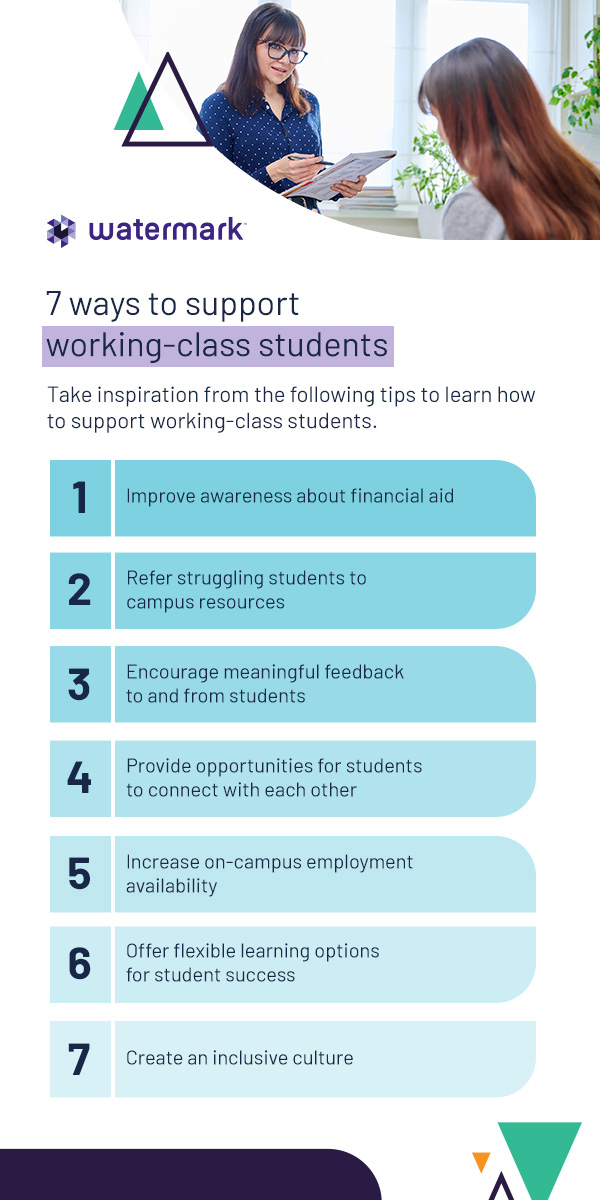




Did you know that first-generation students make up 40 percent of higher education dropouts? Moreover, nearly 90 percent of students from low-income families are likely to drop out of higher education institutions compared to higher-income students. These students face many obstacles on their path to graduation, including keeping up with the expenses necessary to secure their education.
Working-class college students, along with first-year and transfer students, also often struggle to balance their personal lives with academic demands. As a higher education institution administrator, you can play a pivotal role in supporting working-class students by using data-driven insights to identify opportunity gaps and drive student success.
Though all students can encounter barriers to pursuing higher education, those from low-income or first-generation backgrounds often experience a lower sense of belonging, financial hardships, fewer social ties, and stress.
Financial strain or instability is perhaps the most significant challenge that students of all backgrounds face when attending higher education institutions or completing their degrees. A lack of financial stability can prevent some students from seeking loans and accruing debt. Others may lack the resources the succeed academically, especially if they’re supporting other family members or working a job to fund their education.

For example, a Stanford survey revealed that nearly 50 percent of low-income students reported they could not afford an unanticipated $500 expense. This same survey found that 28 percent of students who experienced financial stress felt it impacted their academic performance
Another study found that college students with chronic financial worries resulted in reduced psychological health and academic and social integration. These findings suggest that, with more financial strain, one can be more likely to develop psychological distress and anxiety, which can contribute to dropout rates.
Students can experience scheduling conflicts in many ways, such as when they have two exams on the same day or have an advisor meeting that overlaps with instructor office hours. These conflicts can be exacerbated for students working jobs and juggling a full course load, often resulting in them putting academics on the back burner.
Students who work 15 or more hours per week are more likely to drop out of college. To put this in perspective, a student enrolled full-time at a higher institution who works 15 to 20 hours per week will spend the majority of their week studying, completing assignments, or funding their education. This leaves little room for meeting personal obligations and maintaining relationships. The combination of financial stresses with an increased workload can cause many working-class and first-generation students to drop out.
Student mental health has been heavily researched over the years, highlighting the evidence that higher education students experience moderate to high levels of stress. Upon a closer look, researchers found that as much as 3 in 4 students experience stress across three academic stressors:
The prevalence of stress has undoubtedly contributed to the mental health crisis in college students. According to the National Education Association, at least 60 percent of students meet the criteria for a mental health problem. A recent survey revealed that rates of anxiety and depression in college students are the highest they’ve ever been.
Alternatively, those who experience student loan debt or other types of financial stress often develop anxiety and depression, which can become a cyclical pattern. Research has also shown that higher education institution students are more likely to encounter academic stress and depression if:
All of these factors can impact the ability of a working-class student to perform well academically and maintain their mental health.
It’s no secret that many college students struggle with time management as they adjust to the demands of their new schedules. Like many of the challenges on this list, time management issues can increase for students who juggle jobs, childcare, or academic tutoring sessions with a full semester.

Rigid scheduling can further challenge these students by forcing them to forego valuable studying time to meet other priorities. This can result in students rushing through homework, cramming for exams at the last minute or even losing sleep to meet deadlines. First-generation students who face time management struggles can be at a higher risk of dropping out.
Low-income and first-generation students often have fewer resources at their disposal to set them up for success in higher education institutions. A recent report highlighted that more than half of the undergraduates in the U.S. have jobs, and half of them depend on their earned income to pay for their college education.
What’s more, many students are responsible for supporting other family members. For example, 1 in 5 college students has at least one child, which comes with additional financial responsibilities and time constraints. Others may support an elderly parent or be a caregiver for a sibling.
The socioeconomic status of a family can also directly impact student access to resources and the likelihood of attending higher education institutions. For instance, a first-generation college student may become likely to drop out because they lack access to college-educated family members who can guide or mentor them through academic and financial stresses.
Independence is a vital trait that all students encounter when they enroll in higher education or work a job. This important skill helps students learn how to manage their time and priorities and take responsibility for their actions. However, the U.S. is one of many cultures that idealizes individualism, independence, and self-reliance as a means for achieving success.
This mindset has caused many students to feel pressured to become completely independent when they reach college, which can sometimes turn into hyper-independence. Hyper-independence often prevents individuals from asking for help when they need it or relying on others for support, directly affecting more vulnerable student populations.
For example, research suggests that the focus on independence in the social structure of American universities undermines the academic performance of first-generation students. These independent cultural norms are also associated with higher cortisol — the stress hormone — and negative emotions in first-generation college students.
Though students need independent skills to successfully transition to new life and academic demands, many first-generation college students tend to favor interdependent experiences, comparatively. As a result, many first-generation students are less prepared for higher education institutions compared to their peers, and those who develop hyper-independence often do not use much-needed campus and community support.
Higher institution courses can be challenging, especially for students from low-income communities who are often ill-equipped to balance academic demands and deadlines. Students who received inadequate preparation in high school often have reduced academic readiness at higher institutions.
Many working-class or first-generation students are required to take and pay for remedial or developmental courses that do not count toward degrees. Approximately 50 percent of all students in remedial education do not continue past these courses or complete their credentials. Some majors may require technical, accelerated or higher-level courses, which can put students under a lot of pressure.
Every student has unique needs and circumstances. Consider switching the typical approach to working-class student struggles for innovative methods that directly influence their academic and campus life. Take inspiration from the following tips to learn how to support working-class students.

Minimizing financial stress for working-class students can improve access to higher education and help students prioritize their studies. Financial literacy, in particular, can be a common source of stress due to the complexity of the financial aid system. Even if a student qualifies for financial aid, they may not reap the full benefits unless they understand their responsibilities and options.
Your administration can offer financial counseling sessions for students from underserved backgrounds to help them understand financial aid information, including federal loans, FAFSA, scholarships, and qualifying aid.
You can also provide services that help low-income students apply for loans, teach them about student debt, and assist them in filling out important forms if they don’t know how. Ensure all students understand their financial aid opportunities and how to access and use online financial aid resources.
Higher education institutions often provide a range of resources to support students in need, such as assigning dedicated advisors to assist them on their academic path and teaching them how to maintain a school-life balance. Other services may include:
These resources can offer much-needed support for many struggling students if they’re available on campus. However, a lack of resources is one of the most significant factors that prevent students from seeking help, along with social class stigma and cultural differences.
Additionally, many students who’ve been pressured into hyper-independence may hesitate to admit they’re struggling. Higher education institutions must play the role of identifying at-risk students and referring them to the appropriate resources to give them the support they need.
Receiving feedback is how we improve ourselves. In higher education institutions, the benefits of feedback go both ways. Instructor feedback is essential for first-generation or first-year students who struggle academically. Feedback on their performance enables them to fully understand what they’re doing correctly or incorrectly. Effective feedback can also guide students toward academic support, like peer tutoring, if needed.
Students can also provide meaningful feedback to help instructors learn where they can improve their course, program, or teaching style. Feedback from students of all backgrounds can promote a culture of improvement. Your administration can gather student feedback through surveys, discussions, or forums that will provide critical insight into the experiences of working-class students and their challenges.
The importance of social connection cannot be overstated. Social relationships provide companionship, support, and a sense of belonging, which many low-income and first-generation students lack. and may even promote an individual’s desire to learn. Research shows that student retention and degree completion are influenced by how well they integrate into college life. Higher education institutions can support social connections by:
Working-class students often work part-time jobs to fund their education. Due to scheduling conflicts, commuting, and inconvenient locations, these students may feel added stress trying to balance their work and academic obligations.
Higher education institutions can support learners by promoting on-campus employment opportunities. Jobs available onsite can help students feel more involved in campus life and allow them more free time in their schedules. Employment partnership agreements and programs that allow students to work for credit hours can also provide more flexibility.
On-campus jobs also give students the chance to work with other students, faculty, and staff, which can build their professional opportunities.
The convenience of flexible learning options can be an effective way for administrators to meet unique student needs. Students who work, have children, or have conflicting schedules can take advantage of supports like:
Flexibility for college students has been associated with better retention and improved student outcomes. Some students even report improved mental health as flexible learning options allow them to prioritize their education.
A diverse learning environment helps introduce students to a range of cultural and social groups, which can help low-income and first-generation students feel welcomed and included.
Institutions can promote a positive learning environment by ensuring a diverse curriculum, beginning with inclusive syllabus creation and universal course design. Celebrating diversity, implementing inclusive policies, and hosting inclusive events can also lead to positive outcomes. Diversity and inclusion contribute to the well-being of all students as they increase their multicultural competency and positively change their attitudes and values.
Students of all backgrounds deserve access to quality education. Helping prospective and current students thrive is a top priority, which is why higher education institutions are looking for original solutions to existing challenges. At Watermark, we understand the value of making intentional changes to your institution to drive student success.
We also recognize the barriers that prevent you from accessing and identifying student data necessary for decision-making. If you want to maximize your services, programs, and resources for students, you need the ability to collect and measure data. Watermark Student Success & Engagement solution empowers you to capture a holistic view of the performance and needs of every student so you can offer targeted support. Request a demo of our higher education software today to get started!


























































































































































































































































































































































































Submit this form to schedule a meeting with one of our reps to learn more about our solutions. If you need customer support instead, click here.